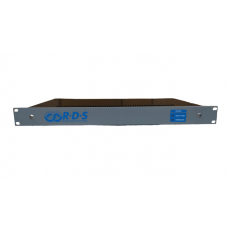- Fully dynamic stand-alone RDS encoder
- Direct digital RDS signal synthesis
- RS-232 control interface based on set of simple ASCII commands or UECP protocol; OS independent, no driver required
- Control software includes powerful Windows GUI application
- Firmware updates are free
- Text features include dynamic PS, parsing, scrolling, fixed messages and scheduling
- Two switchable program sets (with optional DSN and PSN setting)
- Bypass relay, high reliability
- External TA and Program switch
- Switchable MPX loopthrough
- Internal real-time clock incl. backup battery, showing real-time also as PS
- No special 19 kHz input needed - pilot tone internally recovered from MPX signal
- Digital 57 kHz phase locked loop - rock stable RDS subcarrier in all cases, the PLL will never lock to a pilot frequency outside the functional range
- Easy and fast set-up
| RDS services directly supported by the unit |
| | | | |
| PI | Program Identification | M/S | Music/Speech |
| PS | Program Service | PIN | Program-Item Number |
| PTY | Program Type | ECC | Extended Country Code |
| TP | Traffic Program | RT | Radiotext |
| AF | Alternative Frequencies | TDC | Transparent Data Channels |
| TA | Traffic Announcement | IH | In House Applications |
| PTYN | Program Type Name | ODA | Open Data Applications |
| DI | Decoder Identification | CT | Clock-Time and Date |
| EON | Enhanced Other Networks information | LIC | Language Identification Code |
| RT+ | Radiotext Plus | TMC | Traffic Message Channel |
Total text capacity:
- 25 kB - Equivalent to more than 3200 PS strings. Send text messages without any space limitations!
- 100 text messages for off-line operation - up to 255 characters each sent as RT, dynamic/scrolling PS or both. Manual or automatic switching.
- Four modes for dynamic/scrolling PS transmission at selectable speed, incl. word alignment and one-by-one character scrolling.
| Supply voltage and current: | 8-15 V DC, 50 mA typical |
| Total power consumption: | only 0.5 W |
| RDS/RBDS signal: | conforms to CENELEC EN 50067 / EN 62106 |
| Output level of RDS: | adjustable from 0 to 2.8 V p-p |
| RDS signal bandwidth: | +/- 2.4 kHz (50 dBc) |
| Spurious suppression: | >90 dB |
| Harmonics suppression: | >80 dB |
| MPX leadthrough voltage gain: | 1 (guaranteed from 2 Hz to 100 kHz) |
| TA switching: | multimode software or external switch |
| Clock reference: | pilot tone or internal generator |
| 19 kHz pilot PLL capture range: | +/- 4 Hz |
| Pilot tone level: | min. 120 mV p-p |
| Phase shift adjust: | full range in 9.5 degrees steps |
| Signal connectors: | unbalanced, BNC |
| Data connector: | RS-232 (DCE, 9 pins), bidirectional |
| Com. speed: | software switchable 1200-19200 bps |
| Com. mode: | 8 data bits, no parity, 1 stop bit |
| UECP protocol support: | Partial (see the manual for details) |
| ASCII protocol support: | Yes |
| Recommended power supply: | Wall mount adapter 12V/1A DC, 2.1x5.5mm barrel plug (+) inside |
How to connect the rds to a computer?
|
The RDS encoder can be connected to a computer via USB adapter cable or standard serial cable terminated by CANON D-SUB plugs.
As a next step, download the Magic RDS 3 control software and you can start to use the RDS encoder at once.
The RDS encoder can be also controlled from non-Windows operating systems (Linux, MS-DOS, ...) using any RS-232 ASCII terminal. The command set is easy to learn and gives full control over the RDS stream. It's a strong tool also for developers. You can find detailed description of this advanced use in the manual.
Bidirectional interface provides all info about the RDS encoder services status even if it's installed in neighbour room, abutting building or on a transmitter site in mountains. Ethernet connection is supported by the control software as well.
For more information and set-up details download the manual.


